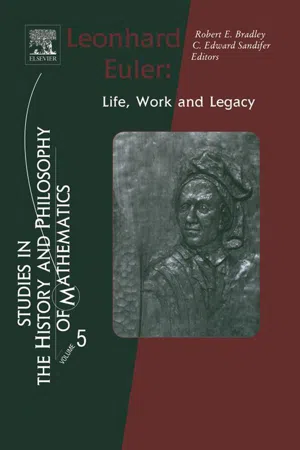
- 542 pages
- English
- ePUB (mobile friendly)
- Available on iOS & Android
About this book
The year 2007 marks the 300th anniversary of the birth of one of the Enlightenment's most important mathematicians and scientists, Leonhard Euler. This volume is a collection of 24 essays by some of the world's best Eulerian scholars from seven different countries about Euler, his life and his work. Some of the essays are historical, including much previously unknown information about Euler's life, his activities in the St. Petersburg Academy, the influence of the Russian Princess Dashkova, and Euler's philosophy. Others describe his influence on the subsequent growth of European mathematics and physics in the 19th century. Still others give technical details of Euler's innovations in probability, number theory, geometry, analysis, astronomy, mechanics and other fields of mathematics and science.- Over 20 essays by some of the best historians of mathematics and science, including Ronald Calinger, Peter Hoffmann, Curtis Wilson, Kim Plofker, Victor Katz, Ruediger Thiele, David Richeson, Robin Wilson, Ivor Grattan-Guinness and Karin Reich- New details of Euler's life in two essays, one by Ronald Calinger and one he co-authored with Elena Polyakhova- New information on Euler's work in differential geometry, series, mechanics, and other important topics including his influence in the early 19th century
Frequently asked questions
- Essential is ideal for learners and professionals who enjoy exploring a wide range of subjects. Access the Essential Library with 800,000+ trusted titles and best-sellers across business, personal growth, and the humanities. Includes unlimited reading time and Standard Read Aloud voice.
- Complete: Perfect for advanced learners and researchers needing full, unrestricted access. Unlock 1.4M+ books across hundreds of subjects, including academic and specialized titles. The Complete Plan also includes advanced features like Premium Read Aloud and Research Assistant.
Please note we cannot support devices running on iOS 13 and Android 7 or earlier. Learn more about using the app.
Information
Cyclotomy: From Euler through Vandermonde to Gauss







Table of contents
- Cover image
- Title page
- Table of Contents
- Copyright page
- Foreword
- Introduction
- Leonhard Euler: Life and Thought
- Leonhard Euler and Russia
- Princess Dashkova, Euler, and the Russian Academy of Sciences
- Leonhard Euler and Philosophy
- Images of Euler
- Euler and Applications of Analytical Mathematics to Astronomy
- Euler and Indian Astronomy
- Euler and Kinematics
- Euler on Rigid Bodies
- Euler’s Analysis Textbooks
- Euler and the Calculus of Variations
- Euler, D’Alembert and the Logarithm Function
- Some Facets of Euler’s Work on Series
- The Geometry of Leonhard Euler
- Cyclotomy: From Euler through Vandermonde to Gauss
- Euler and Number Theory: A Study in Mathematical Invention
- Euler and Lotteries
- Euler’s Science of Combinations
- The Truth about Königsberg
- The Polyhedral Formula
- On the Recognition of Euler among the French, 1790-1830
- Euler’s Influence on the Birth of Vector Mechanics
- Euler’s Contribution to Differential Geometry and its Reception
- Euler’s Mechanics as a Foundation of Quantum Mechanics
- Index